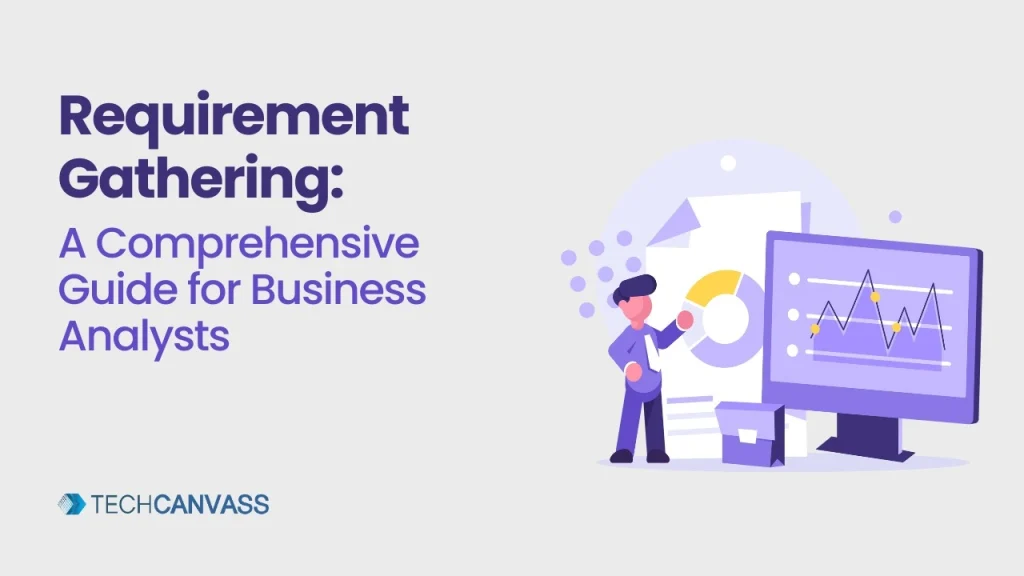Last Updated on September 10, 2025 by Techcanvass Academy
Table of Contents
Overview
Gathering requirements is one of the main jobs of a Business Analyst. It means understanding what a project needs so that the final solution meets business goals. Without clear requirements, projects can easily fail.
A practical way to gather requirements is not just about writing things down. It’s about talking to the right people, asking questions, and using simple methods to find out what they really want. This helps avoid mistakes and keeps everyone on the same page.
In this guide, we’ll walk through easy-to-follow requirement gathering steps like meeting stakeholders, group discussions, observing workflows, creating prototypes, and checking requirements. These approaches make the process smoother and increase the chances of project success.
Useful Link – ECBA Certification Course
Practical approach for requirement gathering
Here are some approaches that you can follow for requirement gathering.
Identify stakeholders
The first step towards requirement gathering is the identification of project stakeholders, which is a crucial part of business analyst requirements. Stakeholders include clients, users, managers, and other relevant individuals with an interest in the outcome of the project. Understanding the views and expectations of each stakeholder is important for aligning project objectives with business goals.
Conduct interviews
Organize individual meetings with stakeholders as part of business analyst requirements to learn more about their specific requirements or expectations. Prepare a list of open-ended questions to encourage detailed answers and uncover any hidden concerns or issues. These interviews provide an ideal opportunity to connect with stakeholders and gain deeper insights into their main issues or areas of interest.
Facilitate group discussions
Organize workshops or meetings to bring stakeholders together and foster collaboration. Group discussions enable stakeholders to share their perspectives, identify common goals, and brainstorm potential solutions collectively. This collaborative approach helps in resolving conflicts, generating new ideas, and building consensus among stakeholders.
Use brainstorming techniques
Organize individual meetings with stakeholders as part of business analyst requirements to learn more about their specific requirements or expectations. As part of business analyst requirements, prepare a list of open-ended questions to encourage detailed answers and uncover any hidden concerns or issues. These interviews provide an ideal opportunity to connect with stakeholders and gain deeper insights into their main issues or areas of interest.
Analyze existing documentation
Studying such documents like business processes, user manuals, and system specifications already available provides some insights into the current practices. Taking this analysis as a basis will help in gathering requirements easier while also setting up the project’s context. Moreover, it ensures that any collected requirement is rooted in existing business process architecture that supports company targets.
Observe workflows
Shadow users or stakeholders while they perform their tasks to gain firsthand insights into their workflows and processes. Observational techniques are essential for understanding their needs, pain points, and challenges in real-world scenarios. By witnessing the workflow in action, business analysts can identify areas for improvement and gather business analyst requirements that address specific user needs.
Prototype and iterate
Create prototypes or mockups as part of business analyst requirements to visualize potential solutions and gather feedback from stakeholders. Prototyping allows stakeholders to interact with the proposed solutions and provide valuable insights for refinement. As part of business analyst requirements, the prototypes should be continuously refined based on stakeholder feedback to ensure their needs are met effectively.
Document requirements
Use a structured approach when documenting these gathered requirements which may include functional/non-functional requirements, use cases, user stories and acceptance criteria etcetera. A clear document will help all involved parties understand what the project is about as well as the scope of its coverage. It also serves as a point of reference for developers during implementation.
Validate requirements
Verify the quality and completeness of the documented requirements as part of business analyst requirements by conducting stakeholder validation. Gather their opinions and address any inconsistencies or gaps in the requirements. This process demonstrates how business analyst requirements gathering aids in risk mitigation and ensures the finished product meets stakeholder expectations.
Prioritize requirements
Work together with stakeholders as part of business analyst requirements to prioritize requirements based on importance, urgency, and practicability. This process ensures that the most critical aspects of a project receive the necessary resources. Additionally, it aids in making well-informed decisions and managing stakeholder expectations effectively.
Communicate effectively
Maintain an open line of communication and transparency with stakeholders throughout the business analyst requirements gathering process. Provide regular updates, seek clarifications when necessary, and ensure that everyone is aligned on project objectives and requirements. Building trust through effective communication enhances collaboration and improves the overall success of the project.
Becoming a Business Analyst: A Guide from Techcanvass Founder & CEO
Conclusion
To sum up, eliciting requirements is an iterative process that calls for precision, cooperation, and clear communication. Through the implementation of diverse strategies and processes, business analysts can ensure that the business analyst requirements*acquired form a strong basis for the project’s success by adhering to an organized strategy.
Business analysts may significantly contribute to providing value to their organizations and stakeholders by becoming experts in requirement collection. In our Business Analyst course, we delve deeper into this process with case studies to enable you to be an efficient Business Analyst.


FAQs on Business Analyst Requirements
Q1. What does it mean when we talk about how business analyst gather requirements?
When we talk about how business analyst gather requirements, it means identifying project needs through discussions with stakeholders, analyzing existing processes, and documenting expectations so the final solution aligns with business goals.
Q2. Who are the stakeholders involved in how business analyst gather requirements?
A key step in how business analyst gather requirements is identifying stakeholders such as clients, users, managers, and anyone impacted by the project. Their input ensures that requirements reflect real business needs.
Q3. What techniques are used in how business analyst gather requirements?
Some of the common techniques in how business analyst gather requirements include interviews, group discussions, brainstorming sessions, workflow observations, prototyping, and analyzing existing documentation.
Q4. Why is documentation important in how business analyst gather requirements?
Documentation is vital in how business analyst gather requirements because it records functional and non-functional needs, use cases, and user stories. Clear documentation helps developers and stakeholders stay aligned throughout the project.
Q5. How does prototyping help in how business analyst gather requirements?
Prototyping is an effective part of how business analyst gather requirements because it allows stakeholders to interact with mockups of the solution, provide feedback, and refine requirements before full-scale development begins.
Q6. What role does communication play in how business analyst gather requirements?
Strong communication is central to how business analyst gather requirements. Regular updates, clarifications, and open discussions build trust, reduce misunderstandings, and keep everyone aligned on project objectives.
Q7. Where can I learn more about how business analyst gather requirements with hands-on training?
To gain practical knowledge of how business analyst gather requirements, you can join the Techcanvass ECBA Training. This course covers requirement elicitation techniques, case studies, and step-by-step guidance to help you become an effective Business Analyst.


